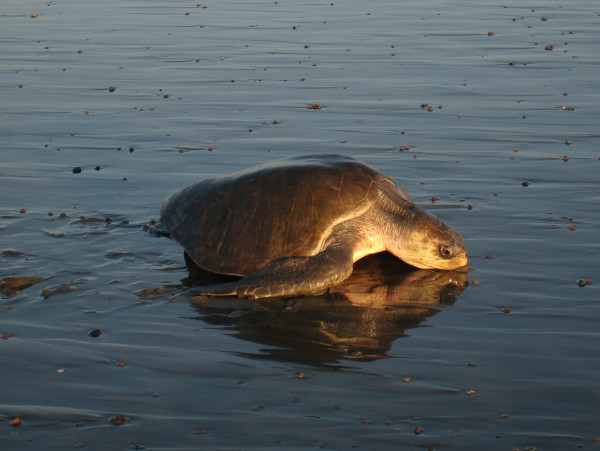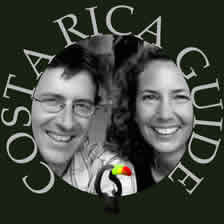
I was flipping though some of our wildlife photo albums when I came to the surprising realization that the tropical animals we’d seen the most intimately weren’t the ubiquitous monkeys, sloths or macaws of the rainforest. It was sea turtles.
It was surprising because we’re not avid SCUBA divers and only occasionally snorkel.
They are sea turtles so it seems only logical that you’d have to spend a lot of time in the water to observe the unique and intimate moments of their lives. I did dive with sea turtles once and it was so thrilling I blew though a whole tank of air almost as fast as the time I spotted a reef shark, but mostly I’ve seen turtles on shore.
As you’d expect from their name they do spend most of their time in the ocean but some of the most interesting and intimate events in their lives occur on the beach.
Birth
The first time we saw sea turtles in Costa Rica it was a delightful surprise.
We saved a few days at the end of a three month bike tour for a “vacation from our vacation.” We stored our bicycles in our friends’ garage in Heredia and hopped on a bus to Nosara with plans to relax on the beach during the day and head north to Playa Ostional at night to see the turtles nesting.
We were disappointed to learn that heavy rains in the mountains (it was late August) would likely keep the Río Nosara and Montaña levels too high to cross (it was years ago and long before they started putting bridges anywhere on the coast road). Since we couldn’t reach Ostional we walked playa Guiones (Nosara) at night even though the locals said the turtles didn’t nest there.

We were taking one last early morning walk on Guiones beach lamenting that while we had enjoyed a few great days on the beach we hadn’t seen the turtles nesting.
Then Sue spotted something black moving near the tree line and we spent the next half hour shooing off stray dogs, zopilotes (vultures) and pizotes (coatimundi) as the tiny sea turtle hatchlings scurried to the water.
We boarded the bus back to the central valley and our flight home to Colorado with huge smiles convinced that watching the babies pop out of the sand, struggle down to the ocean then paddle off into the surf was the perfect first turtle encounter in Costa Rica.
Nesting & Egg Laying
A few years later we were determined to see the arribadas we had heard so much about. Arribadas (arrivals) are mass nesting events where tens of thousands of Olive Ridley (Lepidochelys olivacea) Sea Turtles come ashore to lay eggs in a few nights.
There’s one beach in India and two (Nancite and Ostional) in Costa Rica where arribadas still occur so we headed to Ostional at 2:00 a.m. on a dark night under the sliver of the last quarter moon (the moon phase when the vast majority of the events occur).
It was very late in the season. Usually the big arrivals have wrapped up by the end of January and we were there for Valentines day. We were lucky though and the turtle researchers working on the beach estimated that 8,000 mothers came ashore.
The nesting activity usually lasts a few days with one or two peak nights and the turtles hang around in the waters close to shore for almost a week.
Even from the beach it’s easy to catch glimpses of the adults swimming, feeding and even mating. If you hire a small boat to take you out to the rocky reefs offshore you’ll get a much better view. The currents and surge are strong and can be quite dangerous but if you’re a strong snorkeler or diver there’s no better time to swim with the turtles than when they amass along the coast in preparation for an arribada.
Cruising the clear waters of the Pacific, mating, nesting, hatching and sprinting for the surf we’d seen the most important stages of Sea Turtle’s lives save one.

Death
A few years later we got an intimate look at the last event.
We were spending a long weekend with friends at the house on Sand Dollar cove playa San Miguel and Sue returned from walking the beach with news of a discovery.
It was July and there had been some impressive storms just before we arrived. The surge had cut into the bank at the top of the beach revealing a piece of a sea turtle skull.
The tide was on its way in so we only had a couple of hours to see what lay beneath the exposed fragment of bone. We dug with our hands thrilled each time a scoop revealed more bone.
The waves were lapping at our ankles as we pulled the last few fragments out of the sand and carried them above the high tide line.

The skeleton we re-assembled was remarkably complete and undamaged considering it looked like it had probably spent quite a long time buried just out of reach of average storm surges.
In the evening after the tide receded we carried the bones to the beach and laid them back in the indentation where we’d found them. By morning the waves had eroded another meter of the sandy shelf and returned the skeleton to the sea.

We all wondered how the skeleton came to be entombed in the sand and stayed there long enough for all the flesh to disintegrate and disappear. It must have arrived during a significant storm because local fishermen told us the tide only reached that high on the sand bank with very strong offshore winds.
Who knows, the skeleton may even have belonged to one of the thousands of turtles we’d seen in the previous twenty years – laid as an egg, hatched and scrambling to the ocean, or swimming and mating in the warm waters of Costa Rica.
Jaguars and Turtles
Although we’ve seen way more of the important highlights of Sea Turtle’s lives than almost any other species of Costa Rican wildlife there’s one more scene that we expect we’ll encounter eventually.

Jaguars (Panther onca, Spanish-Tigre) are among the most endangered of the big cats and encounters in the wild are nearly unheard of. However, one of the best places to see one is feeding on a freshly killed sea turtle on the beaches of Tortuguero or Corcovado National Parks.
